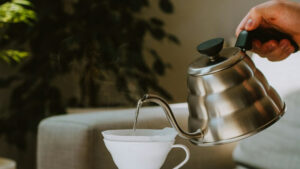
Which Type Of Materials Can You Use To DIY Your Travel Kettle?
Every travel kettle is a potential canvas waiting to be transformed into a piece that not only brews your favorite drinks but also showcases your

Whether you’re road-tripping, camping, or hiking, a travel kettle allows you to conveniently brew coffee, tea, oatmeal, or other hot beverages on the go. But the portable nature of travel kettles also introduces potential safety hazards if the right precautions aren’t in place.
When using electricity and boiling water in a confined, moving vehicle or outdoor setting, safety must be the top priority. In this guide, we’ll cover the key safety features to look for when selecting a travel kettle.
I’ll discuss why auto-shutoff is an absolute must, along with other recommended protections like cool-touch exteriors, boil-dry prevention, and more.
With the information provided here, you’ll be able to confidently choose a well-designed, secure travel kettle to keep your brews safe wherever you wander.
Without question, the number one safety feature required in a travel kettle is automatic shutoff. This is the capability to automatically power down once the water reaches a boil or after a preset time. There are two main types:
Many electric kettles have sensors that detect when the water is boiling. Once bubbling is detected, the kettle will automatically turn off the heating element, even if you don’t manually switch it off.
This prevents accidental boiling or superheating. It also provides peace of mind if you get distracted and forget to power down a boiling kettle manually.
Here’s how the boil detection auto-shutoff works:
Advanced kettles may have multiple sensors to ensure accurate readings. Always test the auto-shutoff when first using a new kettle.
Some kettles have failsafe timed auto shutoff as a backup. If, for some reason, the boil sensor malfunctions, the kettle will still automatically power down after a preset time, like 10 minutes.
This acts as backup protection against potential sensor issues. It also provides limiting heating just in case the kettle is turned on without water.
The timed shutoff uses an integrated circuit board. When the kettle is powered on, the circuit initiates a countdown based on the preset time. Once the countdown completes, the circuit cuts power to the heating element.
Both auto shutoff features are important, with boil detection being the most essential. When searching for a travel kettle, automatic shutoff should be standard. I’d avoid any kettles lacking this important function due to the risks.
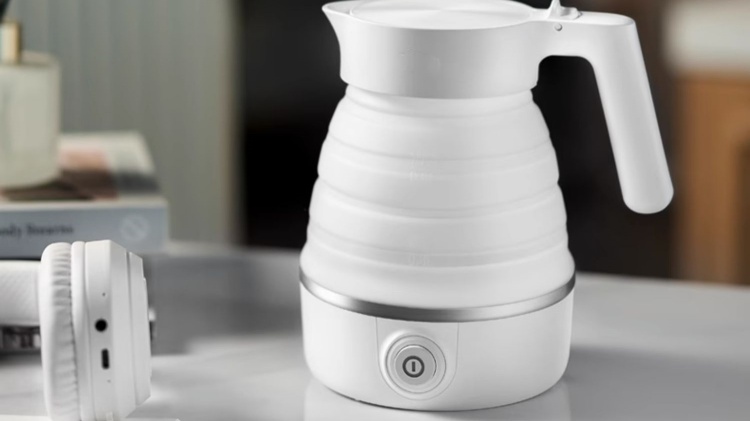
Another key safety element in travel kettles is the cool-touch exterior. Quality kettles are designed with high-grade, durable plastics or insulated stainless steel on the outside of the kettle body.
This creates a protective barrier between the boiling water and the outer surface. Even when actively heating, the kettle should be safe to touch and move without risk of burns.
Cool-touch exteriors may use a combination of plastic, silicone, or rubber coatings. Double-wall stainless steel also provides insulation. This is a mandatory feature to keep hands protected on the road.
Here are some common materials used:
Test the exterior temperature before purchasing by asking to see a floor model boil. It should stay cool enough to hold.
Responsible kettle manufacturers also include boil-dry prevention as a standard. This is the capability to automatically power down if the kettle is turned on without adequate water inside.
Sensors inside the kettle detect a lack of water. Without water to boil, the kettle will shut itself off quickly to prevent the heating element from burning out.
Here’s how boil-dry technology works:
Boil-dry protection provides multiple layers of safety. First, it prevents damage to the kettle itself from overheating without water. It also reduces fire risks, as boiling an empty kettle could ignite any residues inside.
I’d pass on any travel kettle lacking an auto shutoff when running dry. This technology has become standard and is a must for safety.
Spills are inevitable when driving over bumpy terrain or traveling on unsteady boats or trains. That’s why many travel kettles incorporate lid locks to prevent splashing messes.
Look for models with lids that securely snap, twist, or clamp into place. This keeps the lid tightly sealed, and the contents are safely contained within the kettle.
Locking lids paired with leakproof spouts take the stress out of transporting piping-hot liquids. You won’t have to worry about painful spills or stains in your vehicle or pack.
Here are some common lid-locking systems:
Test the lock’s effectiveness by filling it with water and shaking it upside down. No drops should escape!
Don’t underestimate the importance of a sturdy, stay-cool handle on a travel kettle! A handle that absorbs heat or fails to provide a steady grip can lead to accidental drops and burns.
See if the handle has insulation inside to repel heat from the kettle walls. Silicone is commonly used. The handle should allow for comfortable holding without transmitting warmth.
It should also provide a slip-resistant grip, even with wet hands. Look for indented finger holds, textured materials like rubber, and wide shapes for easy clutching from all angles.
Make sure to assess the handle ergonomics before buying. Holding it should feel natural, with no pinching. If you want a solid grip, you can rely on miles from home.

While auto shutoff protects against overheating, some kettles also include helpful boiling alerts. A common one is a whistle built into the spout lid.
When the water hits its boiling point, the whistle sounds to let you know it’s ready. This allows you to turn off the heat without having to constantly monitor the kettle.
Whistles are helpful backups in noisy environments like RVs or campsites where it may be hard to hear the water bubbling. Just listen to the whistle to know when your water is hot and ready.
Here’s how kettle whistles work:
While not essential, whistles provide useful audible boiling alerts on the go.
Beyond the major protections outlined already, here are a few other useful safety features to have:
Along with choosing a travel kettle with ample safety technology built in, you also need to use proper precautions:
With a safe setup and diligent monitoring, you can prevent accidents and enjoy your travel kettle safely.
Despite product testing, occasionally an auto-shutdown mechanism may fail. Here are some troubleshooting tips if your kettle doesn’t power down:
Won’t shut off after boiling:
Doesn’t shut off when empty:
Won’t shut off after preset time:

With portable power and hot water comes an increased responsibility to prevent injuries and damage. But have no fear of modern safety engineering; choosing a secure travel kettle is straightforward.
Simply avoid any kettles lacking auto-shutoff, boil-dry protection, cool exteriors, and locking lids. Seek out models with extras like whistles, wide bases, gauges, and swivel cords too.
Pair your safe kettle with smart precautions, regular maintenance, and close monitoring. With this full approach, you can create cafe-quality coffees and perfectly steeped teas anywhere without compromising safety.
So get out there and explore, knowing you have a well-designed, thoroughly protected travel kettle that has your back. Your next adventure is waiting – just be sure to pack the essential gear to brew safely first!


Every travel kettle is a potential canvas waiting to be transformed into a piece that not only brews your favorite drinks but also showcases your
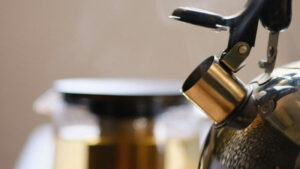
When you think of customizing your travel tea kettle, the idea of adding LED lights probably isn’t the first thing that comes to mind. However,
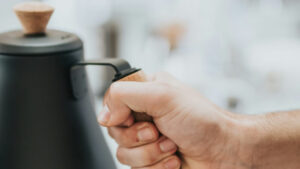
Every travel kettle enthusiast knows the pain of a lukewarm cup of tea or coffee. It’s like expecting a hug and getting a handshake. But

There’s something uniquely comforting about enjoying a hot cup of tea while on the road, but keeping your travel tea kettle warm and protected can

Every travel kettle is a potential canvas waiting to be transformed into a piece that not only brews your favorite drinks but also showcases your
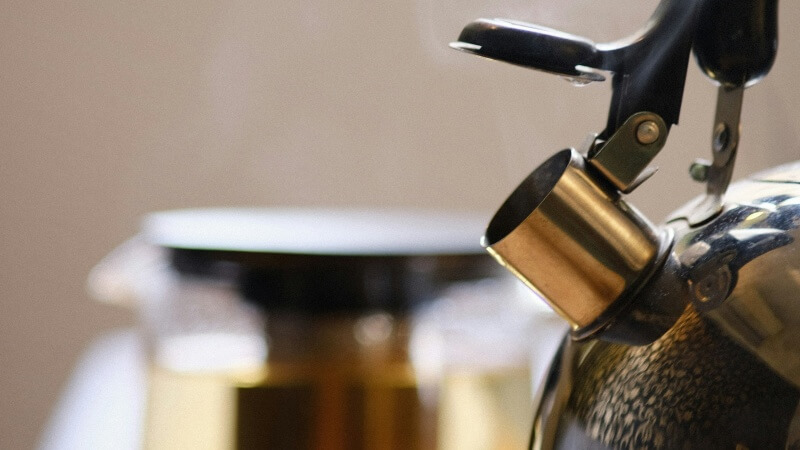
When you think of customizing your travel tea kettle, the idea of adding LED lights probably isn’t the first thing that comes to mind. However,

Every travel kettle enthusiast knows the pain of a lukewarm cup of tea or coffee. It’s like expecting a hug and getting a handshake. But

There’s something uniquely comforting about enjoying a hot cup of tea while on the road, but keeping your travel tea kettle warm and protected can
Copyright © 2024 brewgotravelkettle. All Rights Reserved.